Effects of Microstructure and Chemical Composition on the Visual Characteristics of Flattened Bamboo Board
Abstract
:1. Introduction
2. Materials and Methods
2.1. Materials
2.2. Colorimetric Analyses
2.3. Glossiness Measurements
2.4. SEM Analysis
2.5. FTIR Spectroscopy
2.6. XPS Analysis
2.7. Statistical Analysis
3. Results and Discussion
3.1. Comparison of Visual Physical Quantities between Flattened Bamboo Boards and Control Samples
3.2. Effects of Microstructure Differences on Visual Physical Quantities
3.3. Effects of Chemical Composition Differences on Visual Physical Quantities
3.3.1. FTIR Analysis
3.3.2. XPS
4. Conclusions
Author Contributions
Funding
Data Availability Statement
Acknowledgments
Conflicts of Interest
References
- Lou, Z.C.; Wang, X.Z.; Li, Y.J.; Yang, F.; Zhao, Y.H. Production technology of flattened bamboo flooring with bamboo outer layer. China For. Prod. Ind. 2022, 59, 49–52. [Google Scholar]
- Yuan, T.C.; Han, X.; Wu, Y.F.; Hu, S.H.; Li, Y.J. A new approach for fabricating crack-free, flattened bamboo board and the study of its macro-/micro-properties. Eur. J. Wood Wood Prod. 2021, 79, 1531–1540. [Google Scholar] [CrossRef]
- Zhang, X.C.; Zhou, Z.Z.; Zhu, Y.D.; Dai, J.F.; Yu, Y.M. High-pressure steam: A facile strategy for the scalable fabrication of flattened bamboo biomass. Ind. Crops Prod. 2019, 129, 97–104. [Google Scholar] [CrossRef]
- Sarula; Nakamura, S.; Yoshitani, K.; Tanahashi, M. Development of novel flattening method for bamboo cane by the high-pressure steam processing. Mokuzai Gakkaishi 2012, 58, 193–200. [Google Scholar] [CrossRef]
- Parkkeeree, T.; Matan, N.; Kyokong, B. Flattening of half tubular bamboo culms and fixation of bamboo boards. J. Trop. For. Sci. 2014, 26, 101–114. [Google Scholar]
- Parkkeeree, T.; Matan, N.; Kyokong, B. Mechanisms of bamboo flattening in hot linseed oil. Eur. J. Wood Wood Prod. 2015, 73, 209–217. [Google Scholar] [CrossRef]
- Lou, Z.; Wang, Q.; Sun, W.; Zhao, Y.; Wang, X.; Liu, X.; Li, Y. Bamboo flattening technique: A literature and patent review. Eur. J. Wood Wood Prod. 2021, 79, 1035–1048. [Google Scholar] [CrossRef]
- Yuan, T.C.; Xiao, X.; Zhang, T.; Yuan, Z.R.; Li, Y.J. Preparation of crack-free, non-notched, flattened bamboo board and its physical and mechanical properties. Ind. Crops Prod. 2021, 174, 114218. [Google Scholar] [CrossRef]
- Yuan, T.C.; Wang, X.Z.; Lou, Z.C.; Zhang, T.; Han, X.; Wang, Z.S.; Hao, X.M.; Li, Y.J. Comparison of the fabrication process and macro and micro properties of two types of crack-free, flatten bamboo board. Constr. Build. Mater. 2022, 317, 125949. [Google Scholar] [CrossRef]
- Lian, C.P.; Wang, X.H.; Chen, H.; Fei, B.H.; Pang, X.R.; Lian, J.C.; Wu, Z.H. Using statistical methods to comparatively analyze the visual characteristics of flattened bamboo boards in different bamboo culms. Polymers 2022, 14, 4327. [Google Scholar] [CrossRef]
- Su, N.; Fang, C.H.; Zhou, H.; Tang, T.; Zhang, S.Q.; Wang, X.H.; Fei, B.H. Effect of rosin modification on the visual characteristics of round bamboo culm. Polymers 2021, 13, 3500. [Google Scholar] [CrossRef] [PubMed]
- Mehats, J.; Castets, L.; Grau, E.; Grelier, S. Homogenization of maritime pine wood color by alkaline hydrogen peroxide treatment. Coatings 2021, 11, 839. [Google Scholar] [CrossRef]
- ISO 2813:2014; Paints and Varnishes—Determination of Gloss Value at 20°, 60° and 85°, CEN/TC 139—Paints and Varnishes. International Organization for Standardization:: Geneva, Switzerland, 2014.
- Lian, C.P.; Liu, R.; Zhang, S.Q.; Yuan, J.; Luo, J.J.; Yang, F.; Fei, B.H. Ultrastructure of parenchyma cell wall in bamboo (Phyllostachys edulis) culms. Cellulose 2020, 27, 7321–7329. [Google Scholar] [CrossRef]
- Ding, T.; Peng, W.W.; Li, T. Mechanism of color change of heat-treated white ash wood by means of FT-IR and XPS analyses. J. For. Eng. 2017, 2, 25–30. [Google Scholar]
- Mo, J.Q.; Zhang, W.B. Physical and mechanical properties of heat-treated bamboo using near infrared reflectance spectroscopy. J. For. Eng. 2019, 4, 32–38. [Google Scholar]
- Zhang, Y.M.; Yu, Y.L.; Yu, W.J. Discoloration of heat-treated bamboo material. China Wood Ind. 2009, 23, 5–7. [Google Scholar]
- Cheng, S.; Huang, A.; Wang, S.; Zhang, Q. Effect of different heat treatment temperatures on the chemical composition and structure of Chinese fir wood. BioResources 2016, 11, 4006–4016. [Google Scholar] [CrossRef]
- Jiang, Z.H. World Bamboo and Rattan; China Forestry Publishing House: Beijing, China, 2002. [Google Scholar]
- Lian, C.P.; Wu, Z.H. Research progress on environmental characteristics of bamboo materials and its products. J. For. Eng. 2022, 7, 23–30. [Google Scholar]
- Wang, X.H. Study on Thermal Effect and Wood Property Mechanism of Vacuum Heat Treatment of Eucalyptus Globuli; Chinese Academy of Forestry: Beijing, China, 2012. [Google Scholar]
- Huang, X.N.; Kocaefe, D.; Kocaefe, Y.; Boluk, Y.; Pichette, A. A spectrocolorimetric and chemical study on color modification of heat-treated wood during artificial weathering. Appl. Surf. Sci. 2012, 258, 5360–5369. [Google Scholar] [CrossRef]
- Li, J. Wood Spectroscopy; Science Press: Beijing, China, 2002. [Google Scholar]
- Meng, F.D.; Yu, Y.L.; Zhang, Y.M.; Yu, W.J.; Gao, J.M. Surface chemical composition analysis of heat-treated bamboo. Appl. Surf. Sci. 2016, 371, 383–390. [Google Scholar] [CrossRef]
- Akguel, M.; Guemueskaya, E.; Korkut, S. Crystalline structure of heat-treated scots pine [pinus sylvestris l.] and uludag fir [abies nordmanniana (stev.) subsp. bornmuelleriana (mattf.)] wood. Wood Sci. Technol. 2017, 41, 281–289. [Google Scholar] [CrossRef]
- Zhu, Y.; Zhu, W.; Li, Z.; Feng, Y.; Qi, W.; Li, S.; Wang, X.; Chen, M. Enhancement of Wood Coating Properties by Adding Silica Sol to UV-Curable Waterborne Acrylics. Forests 2023, 14, 335. [Google Scholar] [CrossRef]
- Kotilainen, R.; Toivanen, T.; Alen, R. FTIR monitoring of chemical changes in softwood during heating. J. Wood Chem. Technol. 2000, 20, 307–320. [Google Scholar] [CrossRef]
- Colom, X.; Carrillo, F.; Nogués, F.; Garriga, P. Structural analysis of photodegraded wood by means of FTIR spectroscopy. Polym. Degrad. Stabil. 2003, 80, 543–549. [Google Scholar] [CrossRef]
- Yu, H.X.; Fang, C.R.; Yu, W.J. Research progress on lignin photo degradation mechanism. J. Southwest For. Univ. 2015, 35, 104–110. [Google Scholar]
- Windeisen, E.; Strobel, C.; Wegener, G. Chemical changes during the production of thermo-treated beech wood. Wood Sci. Technol. 2007, 41, 523–536. [Google Scholar] [CrossRef]
- Inari, G.; Petrissans, M.; Lambert, J.; Ehrhardt, J.J.; Gérardin, P. XPS characterization of wood chemical composition after heat-treatment. Surf. Interface Anal. 2006, 38, 1336–1342. [Google Scholar] [CrossRef]
- Yin, Y.F.; Berglund, L.; Salmen, L. Effect of steam treatment on the properties of wood cell walls. Biomacromolecules 2011, 12, 194–202. [Google Scholar] [CrossRef]
- Yamauchi, S.; Lijima, Y.; Doi, S. Spectrochemical characterization by FT-Raman spectroscopy of wood heat-treated at low temperatures: Japanese larch and beech. J. Wood Sci. 2005, 51, 498–506. [Google Scholar] [CrossRef]
- Wikberg, H.; Maunu, S. Characterisation of thermally modified hard-and softwoods by 13C CPMAS NMR. Carbohyd. Polym. 2004, 58, 461–466. [Google Scholar] [CrossRef]

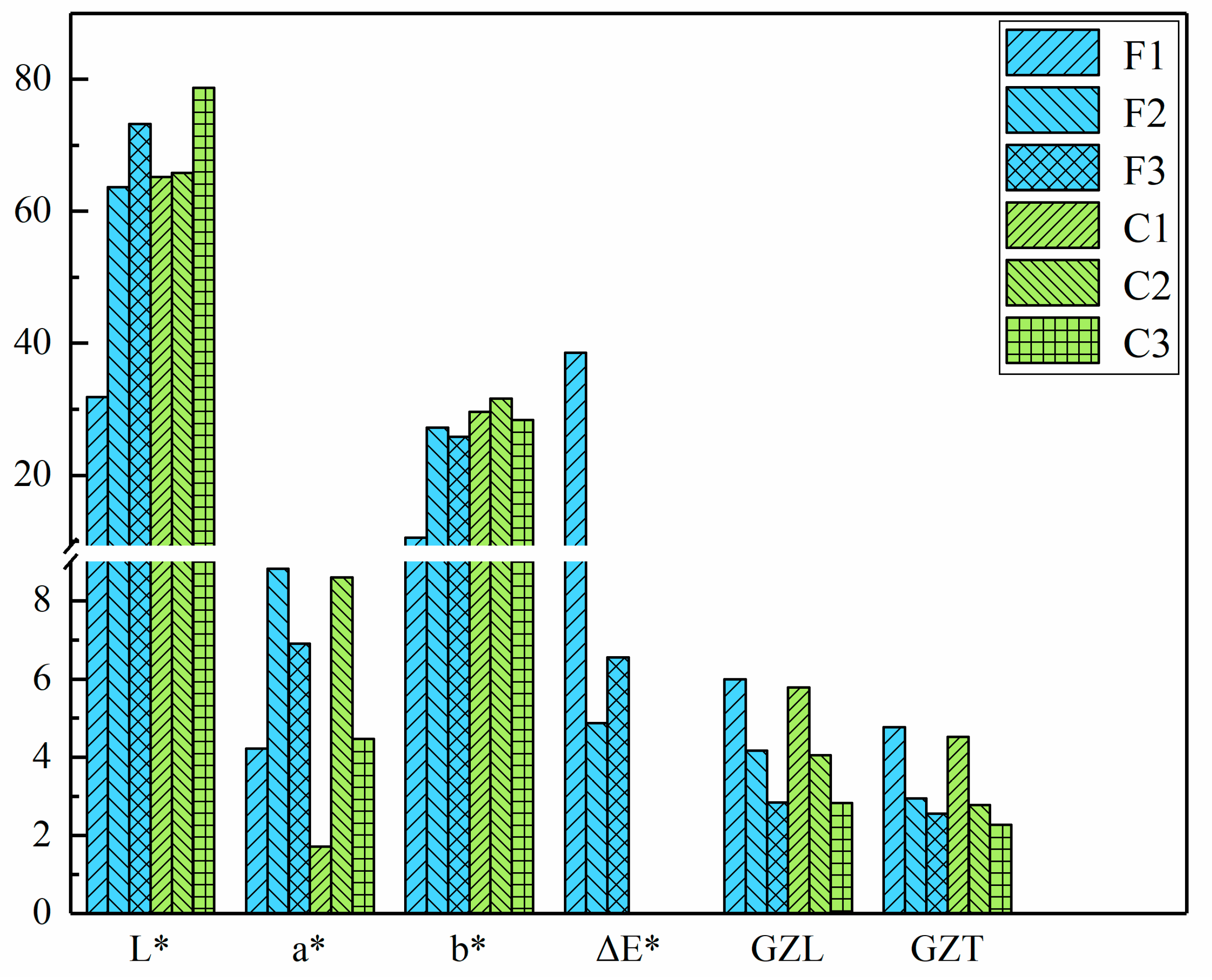
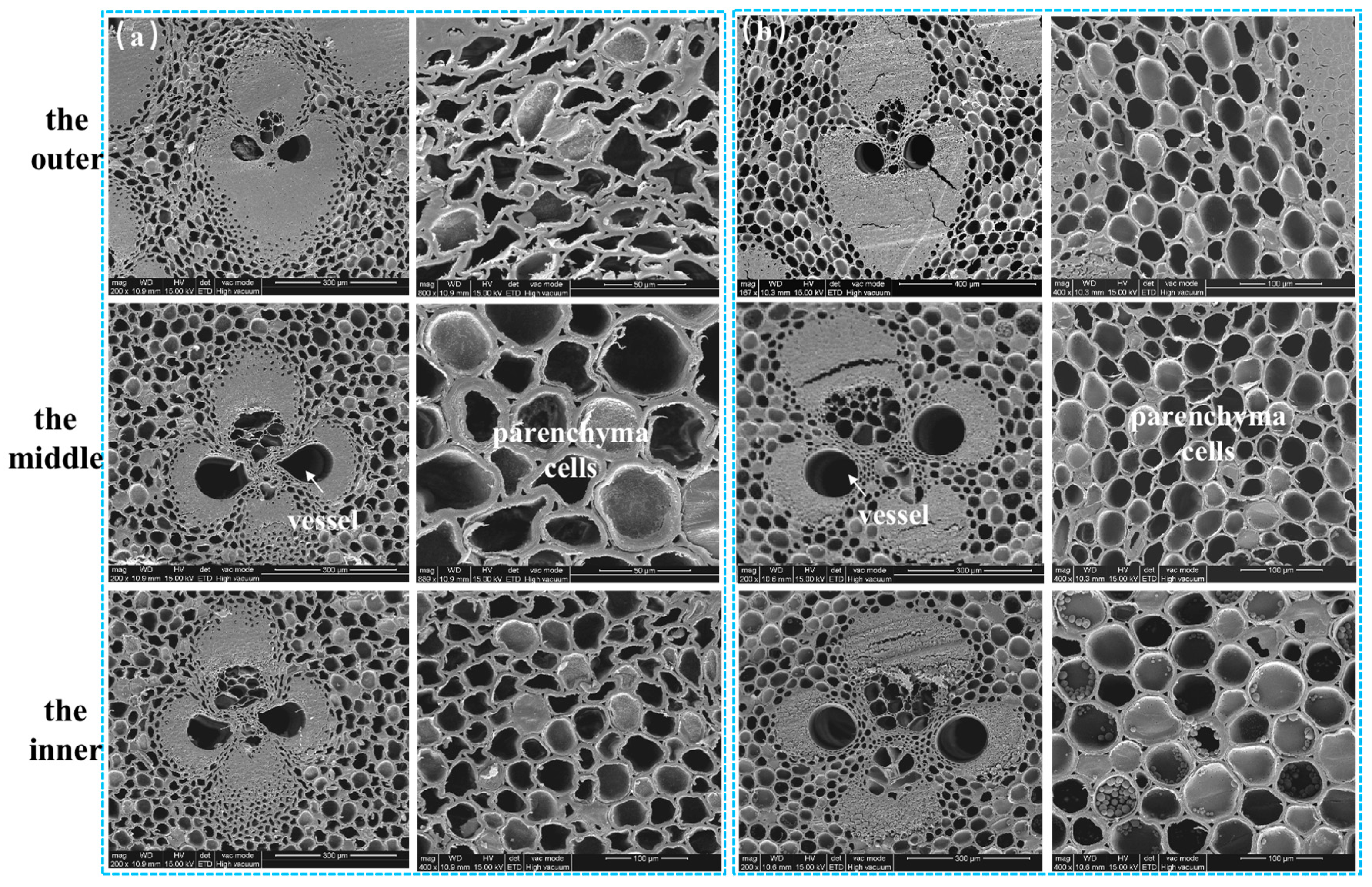

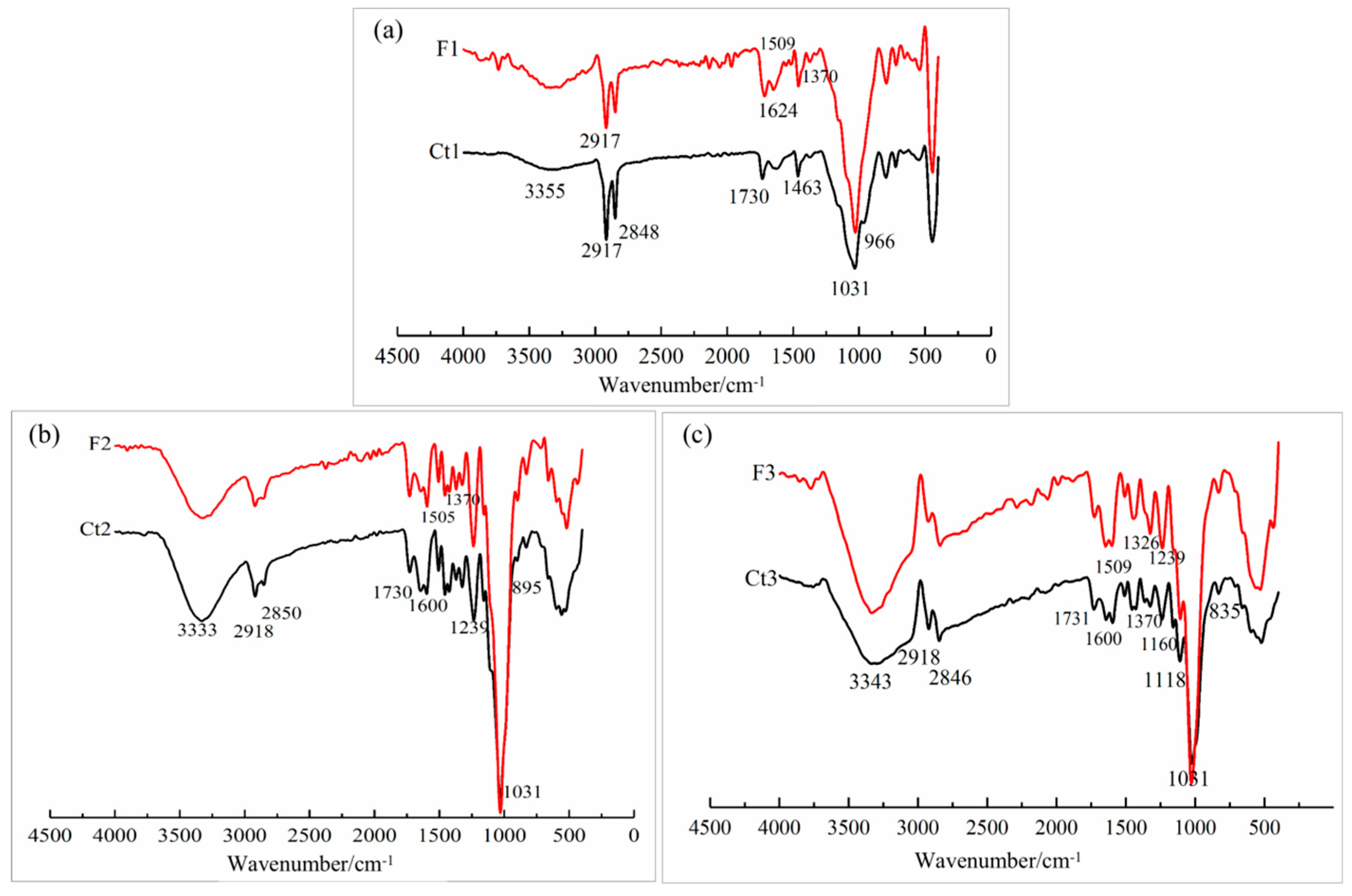
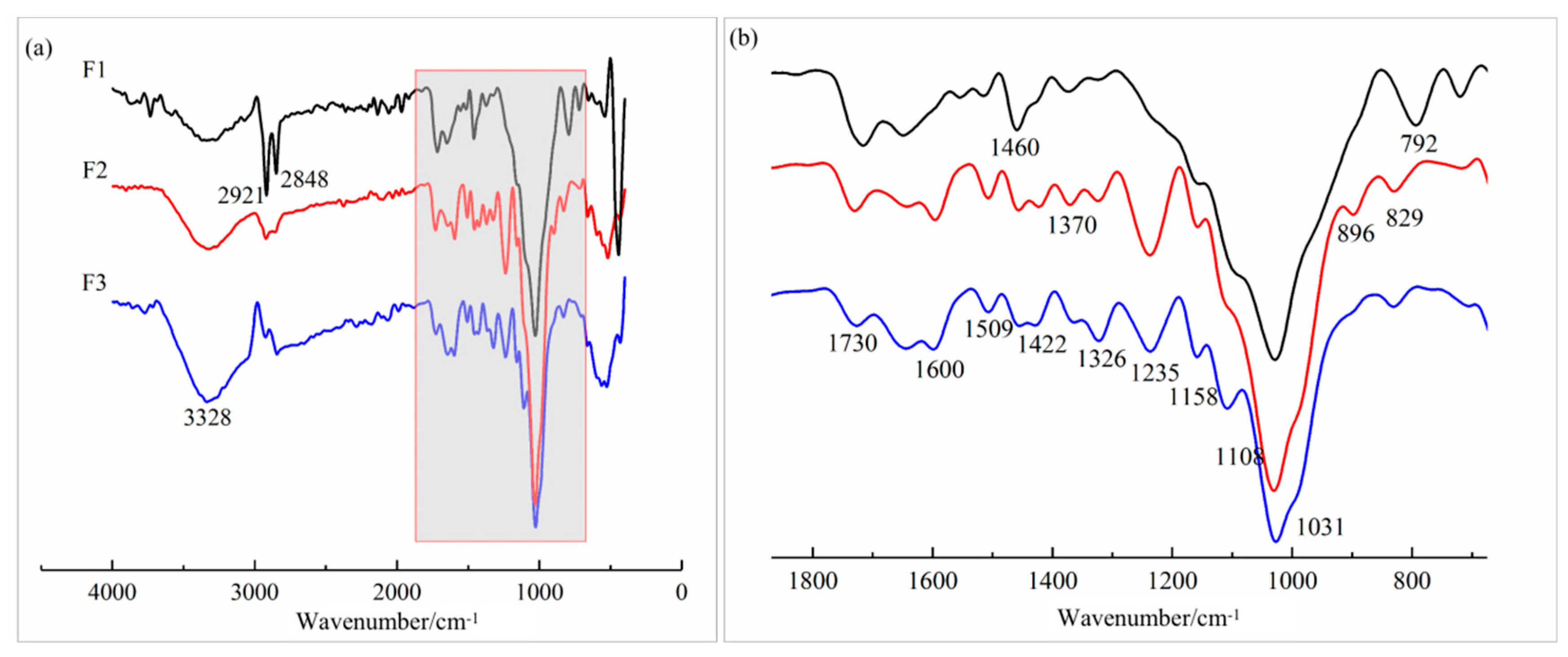

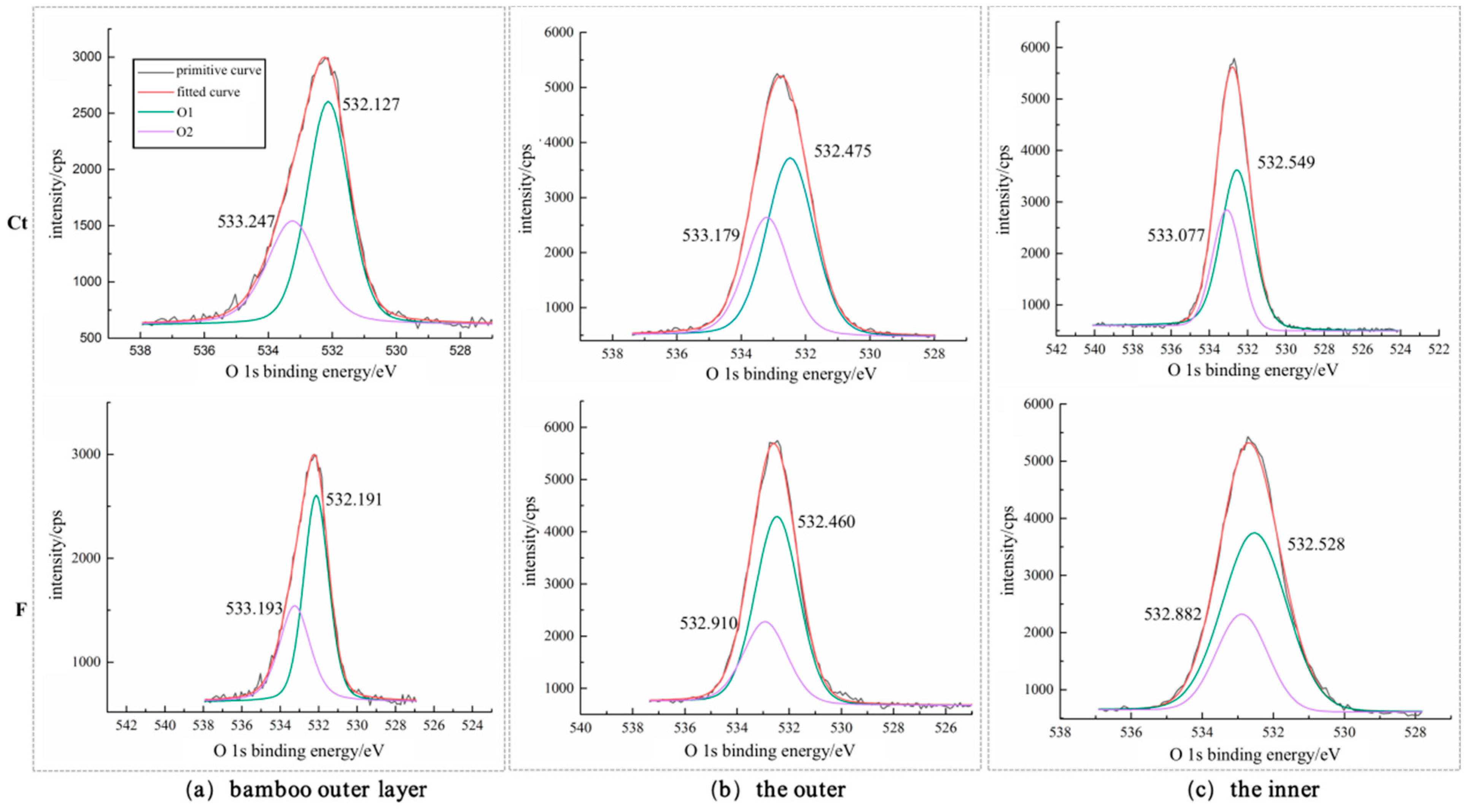
| Sample | L* | a* | b* | ΔE* | GZL (%) | GZT (%) |
|---|---|---|---|---|---|---|
| F1 | 31.82 | 4.23 | 10.54 | 38.55 | 5.99 | 4.77 |
| Ct1 | 65.21 | 1.71 | 29.65 | 5.78 | 4.52 | |
| F2 | 63.67 | 8.82 | 27.23 | 4.88 | 4.17 | 2.95 |
| Ct2 | 65.82 | 8.60 | 31.61 | 4.05 | 2.78 | |
| F3 | 73.21 | 6.91 | 25.82 | 6.55 | 2.85 | 2.56 |
| Ct3 | 78.72 | 4.47 | 28.39 | 2.83 | 2.27 |
| Typical Absorbance Peaks (cm−1) | Assignment |
|---|---|
| 3349 | –OH stretch (hydrogen-bonded) |
| 2917/2848 | C–H stretch (stretching of the methyl and methylene groups; hydrocarbon chains on cellulose) |
| 1730 | unconjugated C=O in xylan (hemicellulose) |
| 1600 | aromatic skeletal vibration (C=C) in lignin |
| 1505 | aromatic skeletal vibration (C=C) in lignin |
| 1460 | –CH3 deformation in lignin and –CH2 bending in xylan |
| 1370 | C–H deformation in cellulose and hemicellulose |
| 1239 | syringyl ring and C–O stretching in lignin and xylan |
| 1108 | C–H stretching (Guaiacyl and syringyl) |
| 1031 | C–O stretching (lignin, cellulose, and hemicelluloses) |
| Element | Binding Energy/eV | Binding Form |
|---|---|---|
| C1 | 284.8 | C–H, C–C |
| C2 | 286.5 | C–OH, C–O–C |
| C3 | 288 | C=O, O–C–O |
| O1 | 532 | OH–C=O |
| O2 | 533 | C–OH |
| Sample | O/C | The Percentage of C Elements in Different Chemical States (%) | The Percentage of O Elements in Different Chemical States (%) | The Percentage of Si (%) | |||
|---|---|---|---|---|---|---|---|
| C1 | C2 | C3 | O1 | O2 | |||
| Ct1 | 0.13 | 71.50 | 24.34 | 4.16 | 61.83 | 28.17 | 15.21 |
| F1 | 0.19 | 73.14 | 23.49 | 3.37 | 79.02 | 20.98 | 6.04 |
| Ct2 | 0.31 | 51.40 | 32.24 | 16.36 | 61.10 | 38.90 | 8.84 |
| F2 | 0.29 | 65.32 | 26.95 | 7.73 | 68.54 | 31.46 | 6.29 |
| Ct3 | 0.32 | 52.70 | 34.93 | 12.37 | 62.01 | 37.99 | 7.77 |
| F3 | 0.31 | 61.76 | 28.41 | 9.83 | 70.32 | 29.78 | 4.95 |
Disclaimer/Publisher’s Note: The statements, opinions and data contained in all publications are solely those of the individual author(s) and contributor(s) and not of MDPI and/or the editor(s). MDPI and/or the editor(s) disclaim responsibility for any injury to people or property resulting from any ideas, methods, instructions or products referred to in the content. |
© 2023 by the authors. Licensee MDPI, Basel, Switzerland. This article is an open access article distributed under the terms and conditions of the Creative Commons Attribution (CC BY) license (https://creativecommons.org/licenses/by/4.0/).
Share and Cite
Chen, L.; Lian, C.; Chen, M.; Wu, Z. Effects of Microstructure and Chemical Composition on the Visual Characteristics of Flattened Bamboo Board. Forests 2023, 14, 2220. https://doi.org/10.3390/f14112220
Chen L, Lian C, Chen M, Wu Z. Effects of Microstructure and Chemical Composition on the Visual Characteristics of Flattened Bamboo Board. Forests. 2023; 14(11):2220. https://doi.org/10.3390/f14112220
Chicago/Turabian StyleChen, Lisheng, Caiping Lian, Meiling Chen, and Zhihui Wu. 2023. "Effects of Microstructure and Chemical Composition on the Visual Characteristics of Flattened Bamboo Board" Forests 14, no. 11: 2220. https://doi.org/10.3390/f14112220
APA StyleChen, L., Lian, C., Chen, M., & Wu, Z. (2023). Effects of Microstructure and Chemical Composition on the Visual Characteristics of Flattened Bamboo Board. Forests, 14(11), 2220. https://doi.org/10.3390/f14112220







